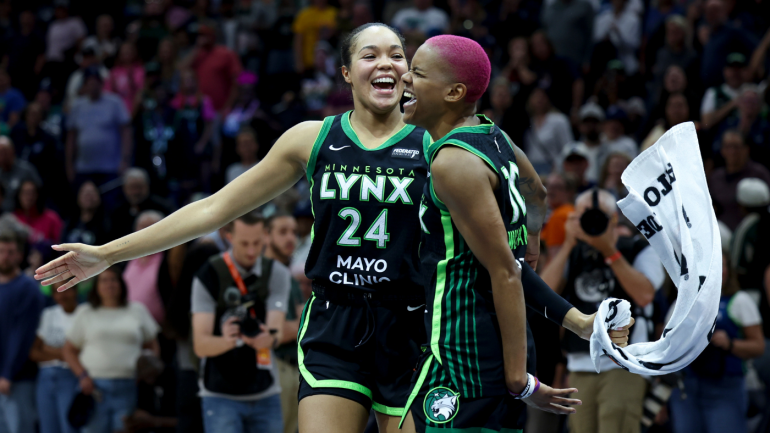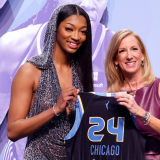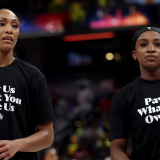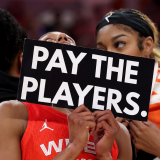WNBA playoffs format: Finals expanding to best-of-seven series highlights changes for 2025
The best-of-three first round will also move from a 2-1 format to a 1-1-1 format

The 2025 WNBA playoffs have arrived. All of the action will tip off on Sunday with a quadruple-header that features Game 1 of all four first-round series, and from there it will be a month-long sprint to crown a new champion. The last possible Finals date is Oct. 17.
As has been the case since 2016, the top eight teams made the postseason regardless of conference affiliation. Here is a look at this season's eight playoff teams, led by the Minnesota Lynx, who earned the No. 1 overall seed and home-court advantage throughout the postseason for the first time since 2017:
- Minnesota Lynx (34-10)
- Las Vegas Aces (30-14)
- Atlanta Dream (30-14)
- Phoenix Mercury (27-17)
- New York Liberty (27-17)
- Indiana Fever (24-20)
- Seattle Storm (23-21)
- Golden State Valkyries (23-21)
The eight playoff teams are then placed into a standard bracket that features No. 1 vs. No. 8, No. 2 vs. No. 7, and so on in the first round. The winners of each series advance until only one team remains standing. The first round series are best-of-three, the semifinals are best-of-five and the Finals are best-of seven.
Here are this year's first-round matchups:
- No. 1 Minnesota Lynx vs. No. 8 Golden State Valkyries
- No. 2 Las Vegas Aces vs. No. 7 Seattle Storm
- No. 3 Atlanta Dream vs. No. 6 Indiana Fever
- No. 4 Phoenix Mercury vs. No. 5 New York Liberty
While the overall playoff structure did not change this season, there are two big differences from last year. Let's take a closer look.
Every team guaranteed a home playoff game
Since moving away from the Eastern Conference vs. Western Conference playoff format and adopting a league-wide top-eight system, the WNBA has tinkered with the opening round(s). From 2016-2021, a convoluted arrangement involving byes and single-elimination games in the first and second rounds was in place. In 2022, the single-elimination games were abandoned in favor of a traditional bracket that began with best-of-three first round series.
From 2022-2024, the best-of-three first round was played under a unique 2-1 format in which the higher seed had the first two games at home. While that gave the higher seeds a chance to sweep the series without going on the road, it also meant that the lower seeds could earn a winner-take-all Game 3 at home by stealing just one of the first two games.
Another criticism of the 2-1 format was that it did not guarantee every team a home playoff game. That critique was brought into sharp focus last season when Caitlin Clark and the Indiana Fever were swept in the first round by the Connecticut Sun. Clark led the Fever to the postseason for the first time since 2016 with a historic rookie season and the fans in Indianapolis didn't even get to see a playoff game at Gainbridge Fieldhouse.
The league listened and last October announced that the first round for the 2025 playoffs would shift to a 1-1-1 format.
Now, the higher seed gets Game 1 and Game 3 (if necessary) at home, and the lower seed gets Game 2 at home. While this change requires more travel, it is far more equitable.
"We have contemplated both these changes since the pandemic, and we would have done it in the current year, but with the Olympic break this year it wasn't possible," WNBA commissioner Cathy Engelbert said. "Now that we have charter [flights] throughout the season and playoffs, it's feasible."
Finals extended to best-of-seven
The 2025 WNBA season was the longest in league history at 44 games per team. There's a good chance the 2025 Finals is the longest ever, too. In addition to altering the first-round schedule, the league extended the Finals from a best-of-five series to a best-of-seven.
A best-of-seven Finals is one of the clearest indications of how far the WNBA has come since its inaugural season in 1997. In the league's first season, the "Finals" wasn't even a series at all, it was one game. Here's a look at how the Finals have grown throughout the league's history:
- 1997: One game
- 1998-2004: Best-of-three
- 2005-2024: Best-of-five
- 2025-present: Best-of-seven
"The league's growth and increased demand for WNBA basketball wil make this the ideal time to expand the schedule, lengthen the Finals and provide fans more opportunities to see the best players in the world compete at the highest level," Engelbert said.


















